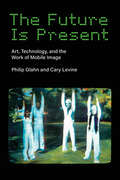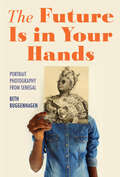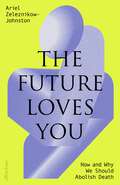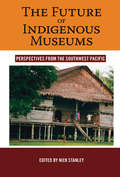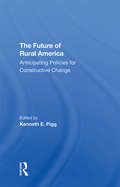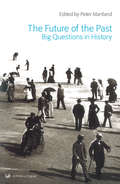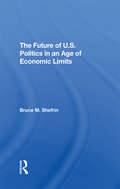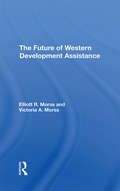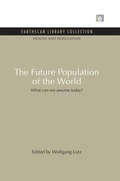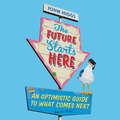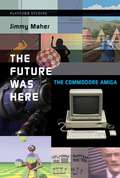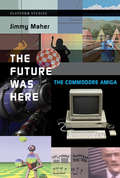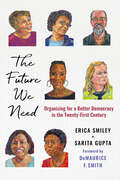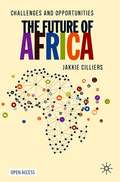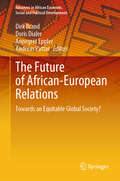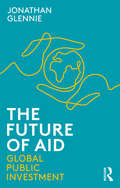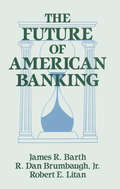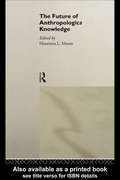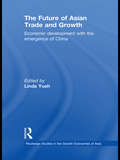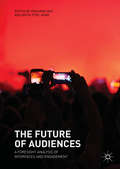- Table View
- List View
The Future Is Present: Art, Technology, and the Work of Mobile Image (Leonardo)
by Cary Levine Philip GlahnA critical history of the pioneering art and technology group Mobile Image and their prescient work in communications, networking, and information systems.In The Future Is Present, Philip Glahn and Cary Levine tell the fascinating history of the visionary art group Mobile Image—founded by Kit Galloway and Sherrie Rabinowitz in 1977—which appropriated emerging technologies, from satellites to electronic message platforms. Based in Los Angeles, this under-studied collective worked amid urban crisis, a techno-boom, consolidating media power, and ascendant neoliberal politics. Mobile Image challenged fundamental conventions of the public sphere, democracy, communication, and political participation, as well as notions of power, representation, and identity.Glahn and Levine argue not only for the historical importance of Mobile Image, but also for a critical artistic process that is at once analytic and transformative. They weave themes such as embodiment and its mediation, public/private dialectics, and techno-utopian vision throughout the book, binding these projects to discourses around race, gender, and class, as well as margin and center, the local and the global. In today&’s world of ubiquitous digital re/production, networking, and social media, The Future Is Present shows how the work of Mobile Image continues to have profound implications for art, technology, and the politics of public and private experience.
The Future Is in Your Hands: Portrait Photography from Senegal (Material Vernaculars)
by Beth BuggenhagenIn Senegal, portraiture serves as a vital index and creator of social connection. People sit for and display portraits, keep albums, and view illustrated magazines together. Through these portraiture practices, Senegalese have fashioned idealized images to mend fraught and fragmented lives in the context of decades of migration. The Future Is in Your Hands provides an expansive frame for photography to highlight the role of affect in portraiture practices. Moving from the colonial to the newly independent Senegal, Beth Buggenhagen combines museum, ethnographic, and archival research on photography's past with lens-based artists who address themes of separation, visibility, rupture, and repatriation through portraiture. Buggenhagen, in collaboration with Senegalese photographers, explores how photographs, as visual and material objects, migrate themselves and, like the bodies they represent, create a record not only of lived experiences but also of the cycle of migration for this labor-exporting country.By complicating the history of portraiture in Senegal, The Future Is in Your Hands reveals the enduring power of images and the efforts under way to keep this art form safely in Senegalese hands.
The Future Loves You: How and Why We Should Abolish Death
by Dr Ariel Zeleznikow-JohnstonA brilliant young neuroscientist explains how to preserve our minds indefinitely, enabling future generations to choose to revive usJust as surgeons once believed pain was good for their patients, some argue today that death brings meaning to life. But given humans rarely live beyond a century – even while certain whales can thrive for over two hundred years – it’s hard not to see our biological limits as profoundly unfair. No wonder then that most people nearing death wish they still had more time.Yet, with ever-advancing science, will the ends of our lives always loom so close? For from ventilators to brain implants, modern medicine has been blurring what it means to die. In a lucid synthesis of current neuroscientific thinking, Zeleznikow-Johnston explains that death is no longer the loss of heartbeat or breath, but of personal identity – that the core of our identities is our minds, and that our minds are encoded in the structure of our brains. On this basis, he explores how recently invented brain preservation techniques now offer us all the chance of preserving our minds to enable our future revival.Whether they fought for justice or cured diseases, we are grateful to those of our ancestors who helped craft a kinder world – yet they cannot enjoy the fruits of the civilization they helped build. But if we work together to create a better future for our own descendants, we may even have the chance to live in it. Because, should we succeed, then just maybe, the future will love us enough to bring us back and share their world with us.
The Future Of Indigenous Museums
by Nick StanleyIndigenous museums and cultural centres have sprung up across the developing world, and particularly in the Southwest Pacific. They derive from a number of motives, ranging from the commercial to the cultural political (and many combine both). A close study of this phenomenon is not only valuable for museological practice but, as has been argued, it may challenge our current bedrock assumptions about the very nature and purpose of the museum. This book looks to the future of museum practice through examining how museums have evolved particularly in the non-western world to incorporate the present and the future in the display of culture. Of particular concern is the uses to which historic records are put in the service of community development and cultural renaissance.
The Future Of Rural America: Anticipating Policies For Constructive Change
by Kenneth PiggIt has been my pleasure to work with a distinguished, committed,and cooperative group of contributors to this volume. They have taught me how to perform the editing role and put up with innumerable and probably insufferable suggestions. I have been privileged to work with exceptionally fine individuals in this endeavor and will count that among my many blessings.
The Future Of The Past: Big Questions in History
by Peter MartlandAt the beginning of the new millennium, The Future of the Past offers a fresh interpretation of the issues and developments that have shaped our world over the last thousand years. By bringing together the expertise of members of the History Faculty at Cambridge University, all of them leaders in their chosen fields, a work of history has been created that is both fascinating and unique. Rather than approaching history as a chain of past events, this book examines some of the key issues facing mankind today and places them into a broad historical context by examining their development throughout the ages. By viewing history through themes such as religious authority, civil liberty, political ideology, demographic change and economic cycles, The Future of the Past challenges many long-held beliefs and enables the reader to reflect upon the dramatic changes of the past and the challenges of the future. As Europe reshapes itself, the question of how it was defined in the past comes to the fore; as Britain experiences devolution, its historical contours and identity are being probed afresh; as the influence of the United States steadily extends across the globe, it compels a reappraisal of the history and responsiveness of Western intellectual, cultural and political traditions. By exploring these issues, The Future of the Past provides an authoritative yet accessible introduction to the study of history and demonstrates how the changing present can revitalize our views of the past.
The Future Of U.s. Politics In An Age Of Economic Limits
by Bruce ShefrinThis study of the future of U.S. politics begins with an in-depth examination of the political, social, and economic dynamics of the present. Dr. Shefrin demonstrates that economic growth has been a key element in maintaining political stability by diverting the attention of materially deprived groups away from disruptive political activity. Examining the interaction of technological and political forces in the physical and social environment, he argues that an expectation of economic limits is reasonable—and perhaps undeniable—and focuses on the changes in the political system that can be anticipated in a no-growth or slow-growth society. Dr. Shefrin employs a nondeterministic "social choice" approach to reach the conclusion that, because the shape of the future is of major political significance, it will be the focus of intense political conflict. The four scenarios he presents reflect the major alternative directions possible for U.S. society, according to current social theory. Dr. Shefrin feels that the conflict among supporters of these alternatives will constitute the politics of the future.
The Future Of Western Development Assistance
by Elliott R Morss Victoria A MorssSince the inception of Western development assistance, significant changes in the makeup of donors, recipients, development goals, and strategies have taken place. However, major donor institutions have not yet weighed the impact of these changes on their operations and objectives in anticipation of the future global environment. Discussing trends that will profoundly affect development assistance strategy, the authors raise such questions as: Will the demand for Western technical assistance drop sharply over the next decade? Was the Latin American debt crisis precipitated by the loan practices of international commercial banks? Should aid to Africa be shifted from investment in rural desert areas to investment in urban planning and infrastructure? Also examined are such concerns as the outside management of agricultural research; the U.S. focus on purchasing political allegiance with its aid programs, thus creating dependent nations; the threat to East Asian economic growth posed by the micro-electronics revolution; and the growing conflict between western aid and trade objectives. The authors' purpose is not to provide definitive prescriptions for future development programs, but rather to focus the attention of policymakers on important, but often neglected, issues.
The Future Population of the World: What can we assume today (Health and Population Set)
by Wolfgang LutzThe highly acclaimed The Future Population of the World contains the most authoritative assessment available of the extent to which population is likely to grow over the next 50 to 100 years. The book provides a thorough analysis of all the components of population change and translates these factors into a series of projections for the population of the world's regions. This revised and updated version incorporates completely new scenario projections based on updating starting values and revised assumptions, plus several methodological improvements. It also contains the best currently available information on global trends in AIDS mortality and the first ever fully probabilistic world population projections. The projections, given up to 2100, add important additional features to those of the UN and the World Bank: they show the impacts of alternative assumptions for all three components (mortality and migration, as well as fertility); they explicitly take into account possible environmental limits to growth; and, for the first time, they define confidence levels for global populations. Combining methodological innovation with overviews of the most recent data and literature, this updated edition of The Future Population of the World is sure to conform its reputation as the most comprehensive and essential publication in the field.
The Future Starts Here: An Optimistic Guide to What Comes Next
by John HiggsWhen we look into the future, we imagine economic collapse, environmental disaster and the zombie apocalypse. But what if we are wrong? John Higgs takes us on a journey past the technological hype and headlines to discover why we shouldn't trust the predictions of science fiction, why nature is not as helpless as we assume and why purpose can never be automated. In the process, we will come to a better understanding of what lies ahead and how, despite everything we can build a better future.
The Future Starts Here: An Optimistic Guide to What Comes Next
by John HiggsAt some point in the 1980s we gave up on the future. Before then, we imagined wonderful days to come, free from disease, work and want, in television series like Star Trek or events such as the 1939 Futurama World Fair. When we look ahead now, we tell dystopian stories of environmental collapse, zombie plagues and the end of civilisation. If it is true that we have to imagine the future before we build it, then this is deeply worrying.There are of course good reasons for this bleak outlook. Serious environmental and societal problems are building, most notably climate change, inequality and population demographics. These will be accompanied by technological advances, including artificial intelligence and biotechnology, which will amplify the rate of change and make the future increasingly unstable and unpredictable.But it is not just technology that is changing. We are changing too. The postmodern world is evolving into a metamodern one. In the metamodern world concepts previously shunned, such as meaning, purpose and sincerity, return not as absolute truths but as necessary tools. While the postmodern world view was detached, cynical and frequently pessimistic, the metamodern is naturally more optimistic. If we engage with the problems of the world, we can overcome them. John Higgs takes us on a journey to find the individuals who are engaging with the changes that are coming, and through that engagement finding their own sense of purpose. As a result, the characters we meet along the way will not be titans of industry or world-renowned experts, but rather regular people who were curious about new technology and who have begun exploring its potential in ways that are meaningful to them. Through their stories, we will come to understand what this much-hyped new technology can and can't do, in order to see past the hype and headlines. In the process, we will come to a better understanding of what lies ahead and how, despite everything - despite all the horrors and instability we face - we can imagine a future worth building.(p) Orion Publishing Group Ltd 2019
The Future Was Here: The Commodore Amiga
by Jimmy MaherLong ago, in 1985, personal computers came in two general categories: the friendly, childish game machine used for fun (exemplified by Atari and Commodore products); and the boring, beige adult box used for business (exemplified by products from IBM). The game machines became fascinating technical and artistic platforms that were of limited real-world utility. The IBM products were all utility, with little emphasis on aesthetics and no emphasis on fun. Into this bifurcated computing environment came the Commodore Amiga 1000. This personal computer featured a palette of 4,096 colors, unprecedented animation capabilities, four-channel stereo sound, the capacity to run multiple applications simultaneously, a graphical user interface, and powerful processing potential. It was, Jimmy Maher writes in The Future Was Here, the world's first true multimedia personal computer. Maher argues that the Amiga's capacity to store and display color photographs, manipulate video (giving amateurs access to professional tools), and use recordings of real-world sound were the seeds of the digital media future: digital cameras, Photoshop, MP3 players, and even YouTube, Flickr, and the blogosphere. He examines different facets of the platform--from Deluxe Paint to AmigaOS to Cinemaware--in each chapter, creating a portrait of the platform and the communities of practice that surrounded it. Of course, Maher acknowledges, the Amiga was not perfect: the DOS component of the operating systems was clunky and ill-matched, for example, and crashes often accompanied multitasking attempts. And Commodore went bankrupt in 1994. But for a few years, the Amiga's technical qualities were harnessed by engineers, programmers, artists, and others to push back boundaries and transform the culture of computing.
The Future Was Here: The Commodore Amiga (Platform Studies)
by Jimmy MaherExploring the often-overlooked history and technological innovations of the world's first true multimedia computer.Long ago, in 1985, personal computers came in two general categories: the friendly, childish game machine used for fun (exemplified by Atari and Commodore products); and the boring, beige adult box used for business (exemplified by products from IBM). The game machines became fascinating technical and artistic platforms that were of limited real-world utility. The IBM products were all utility, with little emphasis on aesthetics and no emphasis on fun. Into this bifurcated computing environment came the Commodore Amiga 1000. This personal computer featured a palette of 4,096 colors, unprecedented animation capabilities, four-channel stereo sound, the capacity to run multiple applications simultaneously, a graphical user interface, and powerful processing potential. It was, Jimmy Maher writes in The Future Was Here, the world's first true multimedia personal computer.Maher argues that the Amiga's capacity to store and display color photographs, manipulate video (giving amateurs access to professional tools), and use recordings of real-world sound were the seeds of the digital media future: digital cameras, Photoshop, MP3 players, and even YouTube, Flickr, and the blogosphere. He examines different facets of the platform—from Deluxe Paint to AmigaOS to Cinemaware—in each chapter, creating a portrait of the platform and the communities of practice that surrounded it. Of course, Maher acknowledges, the Amiga was not perfect: the DOS component of the operating systems was clunky and ill-matched, for example, and crashes often accompanied multitasking attempts. And Commodore went bankrupt in 1994. But for a few years, the Amiga's technical qualities were harnessed by engineers, programmers, artists, and others to push back boundaries and transform the culture of computing.
The Future We Need: Organizing for a Better Democracy in the Twenty-First Century
by Erica Smiley Sarita GuptaIn The Future We Need, Erica Smiley and Sarita Gupta bring a novel perspective to building worker power and what labor organizing could look like in the future, suggesting ways to evolve collective bargaining to match the needs of modern people—not only changing their wages and working conditions, but being able to govern over more aspects of their lives.Weaving together stories of real working people, Smiley and Gupta position the struggle to build collective bargaining power as a central element in the effort to build a healthy democracy and explore both existing levers of power and new ones we must build for workers to have the ability to negotiate in today and tomorrow's contexts. The Future We Need illustrates the necessity of centralizing the fight against white supremacy and gender discrimination, while offering paths forward to harness the power of collective bargaining in every area for a new era.
The Future and Its Enemies: In Defense of Political Hope
by Daniel InnerarityHumans may be the only creatures conscious of having a future, but all too often we would rather not think about it. Likewise, our societies, unable to deal with radical uncertainty, do not make policies with a view to the long term. Instead, we suffer from a sense of powerlessness, collective irrationality, and perennial political discontent. InThe Future and Its Enemies, Spanish philosopher Daniel Innerarity makes a plea for a new social contract that would commit us to moral and political responsibility with respect to future generations. He urges us to become advocates for the future in the face of enemies who, oblivious to the costs of modernization, press for endless and unproductive acceleration. His accessible book proposes a new way of confronting the unknown-one grounded in the calculation of risk. Declaring the classical right-left divide to be redundant, Innerarity presents his hopes for a renewed democracy and a politics that would find convincing ways to mediate between the priorities of the present, the heritage of the past, and the challenges that lie ahead.
The Future and Its Enemies: The Growing Conflict Over Creativity, Enterprise,
by Virginia PostrelToday we have greater wealth, health, opportunity, and choice than at any time in history. Yet a chorus of intellectuals and politicians laments our current condition -- as slaves to technology, coarsened by popular culture, and insecure in the face of economic change. The future, they tell us, is dangerously out of control, and unless we precisely govern the forces of change, we risk disaster.In The Future and Its Enemies, Virginia Postrel explodes the myths behind these claims. Using examples that range from medicine to fashion, she explores how progress truly occurs and demonstrates that human betterment depends not on conformity to one central vision but on creativity and decentralized, open-ended trial and error. She argues that these two opposing world-views -- "stasis" vs. "dynamism" -- are replacing "left" and "right" to define our cultural and political debate as we enter the next century.In this bold exploration of how civilizations learn, Postrel heralds a fundamental shift in the way we view politics, culture, technology, and society as we face an unknown -- and invigorating -- future.
The Future in Minutes (In Minutes)
by Keith MansfieldWHAT DOES THE FUTURE HOLD?200 FUTURISTIC CONCEPTS, TECHNOLOGIES, AND THEIR CONSEQUENCES, EXPLAINED IN AN INSTANTHow will we live, work, and entertain ourselves? What new technologies will emerge? Will humanity evolve--and perhaps live forever? Or are we facing threats that could end us--and even the whole universe?The Future in Minutes tackles these and many other fundamental questions, concisely and lucidly explaining everything from crypto currencies and world governments to gene therapy and colonizing planets--and painting our options for utopia or disaster. Contents include: Predicting the Future; How We'll Live; Shifts in Society; Technology of the Future; Scarcity and Solutions; Politics, Warfare, and Ethics; The Quest for Immortality; Transhumans and Posthumans; Artificial Intelligence; Threats to Humanity; Space Travel and Colonization; Super-Advanced Science; and The Fate of the Earth and the Universe.
The Future of Africa: Challenges and Opportunities
by Jakkie CilliersThis open access textbook offers a critical introduction to human and economic development prospects in Africa revolving around three questions: where is Africa today, what explains the current state, and, given historical trends and what we know about the world, where do we think the continent will be in 2040? And, a final question: what can we do to create a better tomorrow? It models ambitious progress in health, demographics, agriculture, education, industrialization, technological leapfrogging, increased trade, greater stability, better governance and external support. The book reviews the future of work/jobs, poverty and the impact of climate change. A combined Closing the Gap scenario presents a forecast of what could be possible by 2040. Each chapter suggests which policies might accelerate prospects for each sector. Written in an accessible style, and supported by a range of pedagogical features, this textbook introduces undergraduate and graduate students to the contemporary human and economic development prospects in Africa.
The Future of African-European Relations: Towards an Equitable Global Society? (Advances in African Economic, Social and Political Development)
by Doris Dialer Dirk Brand Annegret Eppler Andreas PattarThis book explores the future of African-European relations with a focus on achieving equity in a global context. Drawing on the expertise of policymakers, institutional stakeholders, scholars, and practitioners from both the global south and the global north, this contributed book offers unique insights into successful cooperation strategies between Africa and Europe. By offering case studies and clear perspectives, the book covers topics such as the implementation of public policies, the role of culture and languages, judicial independence, e-governance, technical cooperation and project management, energy crisis, economic growth, and global health. Moving beyond conventional development rhetoric and geopolitical divides, this book creates a common narrative for fostering an equitable global society. This book goes beneath the general development rhetoric, exploring the underlying dynamics of African-European societies, their local practices, and cultures. It also critically examines the post-pandemic global health architecture and the energy crisis from an African-European perspective. Additionally, it includes a dedicated chapter on the influential role of culture in shaping African-European relations.
The Future of Aid: Global Public Investment
by Jonathan GlennieInternational cooperation has never been more needed, but the current system of “aid” is outdated and ineffective. The Future of Aid calls for a wholesale restructuring of the aid project, a totally new approach fit for the challenges of the 21st century: Global Public Investment. Across the world, billions of people are struggling to get by in unequal and unsustainable societies, and international public finance, which should be part of the answer, is woefully deficient. Engagingly written by a well-known expert in the field, The Future of Aid calls for a series of paradigm shifts. From a narrow focus on poverty to a broader attack on inequality and sustainability. From seeing international public money as a temporary last resort, to valuing it as a permanent force for good. From North-South transfers to a collective effort, with all paying in and all benefitting. From outdated post-colonial institutions to representative decision-making. From the othering and patronising language of “foreign aid”, to the empowering concept of Global Public Investment. Ten years ago, in The Trouble with Aid, Jonathan Glennie highlighted the dangers of aid dependency and the importance of looking beyond aid. Now he calls for a revolution in the way that we think about the role of public money to back up our ambitious global objectives. In the wake of the COVID-19 crisis, it is time for a new era of internationalism.
The Future of American Banking (Columbia University Seminars Ser.)
by James R. Barth Robert E. Litan R.Dan BrumbaughThe future of American banking is in doubt and the industry and the federal insurance fund that helps support it are in turmoil. The ingredients of the turmoil have been simmering in public view since at least the early 1980s when commercial bank loans to lesser developed countries (LDCs) began to default. The difficulties began to boil at the end of the decade when the prospect first arose that the banks' deposit insurer, the Bank Insurance Fund (BIF) that is administered by the Federal Deposit Insurance Corporation (FDIC), might require dollars to resolve bank failure as occurred in the savings and loan debacle. This book frames the major economic and policy issues raised by the banking crisis whose resolution largely determines the future of American banking. It focuses on the current reported condition of the banking industry, concentrating on large banks in particular. A longer-run economic prognosis for the banking industry is presented and the implications of future bank failures for the financial services sector and federal regulatory policy are discussed. Most importantly the book contains suggestions for changes in the nation's deposit-insurance system and accompanying banking laws. These changes would reduce the federal government's deposit insurance liability and would provide banks with potentially profitable opportunities. The study includes a wealth of data on the financial condition of American banks and the system as a whole, some of it not easily obtainable from any other source. The authors are internationally recognized as knowledgeable experts on the state of the American banking system and the options and prospects for US banking reform.
The Future of Anthropological Knowledge (ASA Decennial Conference Series: The Uses of Knowledge)
by Henrietta L. MooreThe Future of Anthropological Knowledge the chapters explore the question of the nature of social knowledge from a variety of perspectives and locations such as China, Africa, the USA and elsewhere. By examining the changing nature of anthropological knowledge and of the production of that knowledge, this book challenges the notion that only western societies have produced social theories of modernity and of global scope. Knowledge of society can no longer be restricted to a knowledge of face-to-face social relations but must encompass the effect of technology, global consumption patterns and changing geo-political configurations. The Future of Anthropological Knowledge will be of interest to anthropologists and students of culture and society.
The Future of Architecture in 100 Buildings
by Marc KushnerPart of the TED series: The Future of Architecture in 100 BuildingsA pavilion made from paper. An inflatable concert hall. A building that eats smog. A bridge that grows grapes. The Future of Architecture in 100 Buildings captures the soaring confidence, the thoughtful intelligence, the futuristic wonder, and at times the sheer whimsy of the world's most inspired and future-looking buildings. As author Marc Kushner explains, 'The future of architecture is not one of any dominant style, but rather a world of constant innovation and experimentation.' Like an architectural cabinet of wonders, the book captures this glorious global diversity. From soaring steel towers to bamboo bungalows; from iconic monuments to ingenious children's playgrounds, each page offers an unexpected glimpse of architecture's potential. Through his book and TEDTalk, Kushner suggests that in the age of social media, buildings speak louder than ever. Everyone with a smartphone has become an architectural photographer, snapping selfies with the world's most photogenic buildings. And this constant stream of photos ensures that architecture is now in conversation with the world. Its future matters more - and to more of us - than ever. Aimed at this new, broad audience for architecture, this is an essential and delightful guide to the future being built around us.
The Future of Asian Trade and Growth: Economic Development with the Emergence of China (Routledge Studies in the Growth Economies of Asia)
by Linda YuehThis book presents a comprehensive analysis of current trends of trade and economic growth in Asia, assessing how they are likely to develop in the future. It examines the evolving patterns of Asian economic development with the emergence of China, including since China’s accession to the World Trade Organisation (WTO) in 2001. It is written by experts specialising in economic growth and regional and global trade/investment issues, alongside country specialists who have examined the development path of Asian economies. It discusses the significance of a export-oriented growth strategy on the Asian region, and the likely patterns of intra-regional specialisation given China’s rise. The book examines the degree to which the remarkable growth of China is likely to affect other Asian countries in terms of global market share, and growth prospects. The book explores how the rise of intra-industry trade is affecting patterns of specialisation in the region, and appraises the role of multinational corporations and foreign direct investment. Informed by the latest empirical economic thinking, this book is a rigorous examination of the influence of an emerging economic superpower, and the future for economic growth in Asia. Readers interested in the implications of the rise of China, the effect on the economic development path of the most successful developing nations of our time and the lessons to be heeded from China’s integration with the global economy will find this a thorough yet accessible account of the influence of an emerging economic superpower.
The Future of Audiences: A Foresight Analysis Of Interfaces And Engagement
by Brita Ytre-Arne Ranjana DasThis book brings together contributions from scholars across Europe to present findings from a foresight analysis exercise on audiences and audience analysis, looking towards an increasingly datafied world and anticipating the ubiquity of the internet of things. The book uses knowledge emerging out of three foresight exercises, produced in co-operation with more than 50 stake-holding organisations and building on systematic reviews of audience research. It works through these exercises to arrive at a renewed agenda for audience studies within communication scholarship in the context of intrusive and connected interfaces and emerging communicative practices.
